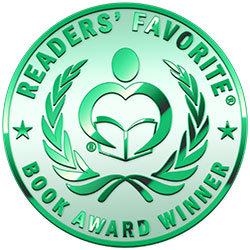
 This author participates in the Readers' Favorite Free Book Program, which is open to all readers and is completely free. The author will provide you with a free copy of their book in exchange for an honest review. You and the author will discuss what sites you will post your review to and what kind of copy of the book you would like to receive (eBook, PDF, Word, paperback, etc.). To begin, click the purple email icon to send this author a private email.
This author participates in the Readers' Favorite Free Book Program, which is open to all readers and is completely free. The author will provide you with a free copy of their book in exchange for an honest review. You and the author will discuss what sites you will post your review to and what kind of copy of the book you would like to receive (eBook, PDF, Word, paperback, etc.). To begin, click the purple email icon to send this author a private email.

Reviewed by Maria Victoria Beltran for Readers' Favorite
J Bradley Van Tighem’s novel Puha, Master of the Wild, Volume 1, unravels in the late 1700s, when wolves, buffaloes, and grizzly bears freely wandered the southern plains of Texas. This was also the time when Comanche Indians roamed the land with their horses, spears, knives, bows and arrows, and puha or spiritual power. In this setting, a 12-year-old white boy, who will later earn the name Many Wolves, is adopted by Painted Wings and Red Arrow of the Lipan Comanche tribe. He is frequently bothered by memories of the murder of his real parents by men with painted faces. When his adopted tribe is attacked by the Nokoni Comanche, led by Laughing Crow, who wants to take him in exchange for peace, Many Wolves has to escape into the wilderness of the Texan desert and survive with the help of his animal friends. Laughing Crow is a cruel, ruthless, and powerful warrior while Many Wolves is a gangling little boy who has the gift of walking with the spirits of the animals. In the near future, the bloody paths of these two main protagonists will meet again.
Puha refers to an Indian word, which means spiritual power. This historical novel deals with the Comanche Indian tribe, America’s indigenous people who used to live freely and in harmony with nature. The author’s writing style is fast paced and descriptive. He is certainly able to capture the Comanche spirit. Feared by the colonizers and other Indian tribes, a Comanche warrior can ride his horse faster and farther than almost anyone, and is as skilled with his spears, bow and arrows, or bare hands. Puha, Masters of the Wild, is a well researched story that provides the reader with a lot of information about how the Comanches actually lived at that time. It is interesting to learn about their customs and traditions and their everyday life. The characters in this novel are so well developed and their adventures are described quite vividly that one can imagine how the great warrior Laughing Crow actually killed his enemies. Although it is hard to imagine the life and times of this Indian tribe in today’s modern world, J. Van Tighem succeeded in bringing them to life again in his reader’s imagination with this novel.